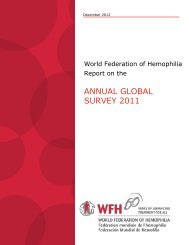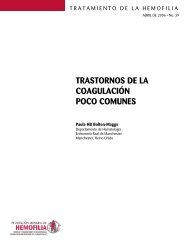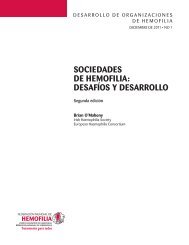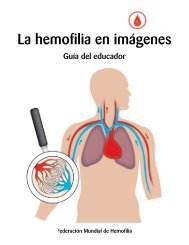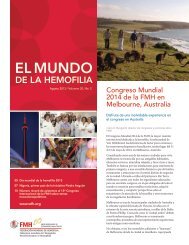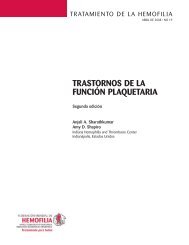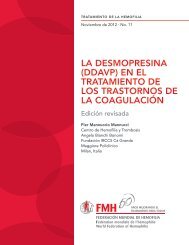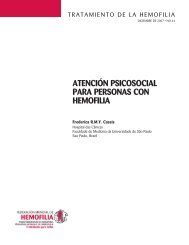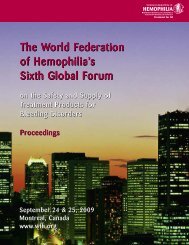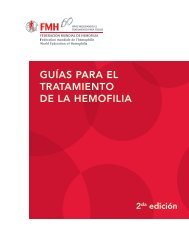Guide for the Assessment of Clotting Factor Concentrates
Guide for the Assessment of Clotting Factor Concentrates
Guide for the Assessment of Clotting Factor Concentrates
You also want an ePaper? Increase the reach of your titles
YUMPU automatically turns print PDFs into web optimized ePapers that Google loves.
used to manufacture <strong>the</strong>se products, including clotting factor concentrates. <strong>Assessment</strong>s <strong>for</strong> estimating<strong>the</strong> risk posed by <strong>the</strong>se products have been developed by regulatory authorities including <strong>the</strong> U.S. FDA 3 ,using principles also described by <strong>the</strong> WFH. We have several relevant publications at www.wfh.org.All <strong>the</strong> estimates agree that <strong>the</strong> risk is strongly dependent on <strong>the</strong> level <strong>of</strong> clearance contributed by <strong>the</strong>process, and that higher purity products pose lower risk levels as <strong>the</strong> infective agent is removed moreeffectively. This should be considered when assessing <strong>the</strong> safety <strong>of</strong> concentrates, while keeping inmind that even <strong>the</strong> recipients <strong>of</strong> low purity products manufactured from plasma pools collected during<strong>the</strong> period <strong>of</strong> BSE penetration into <strong>the</strong> U.K. food chain have not developed vCJD, despite <strong>the</strong> U.K.authorities’ conclusion that <strong>the</strong>se patients have an enhanced risk <strong>of</strong> developing vCJD compared to <strong>the</strong>general U.K. population 4 .In summary, it is important to reiterate that <strong>the</strong>re have been no cases <strong>of</strong> vCJD transmitted by plasmaproducts, including clotting factor concentrates. Bleeding continues to be <strong>the</strong> major cause <strong>of</strong> mortalityand morbidity <strong>for</strong> people with hemophilia, and it is important to retain access to products which preventthis event. Regulatory authorities and manufacturers are now fully aware <strong>of</strong> <strong>the</strong> risk <strong>of</strong> vCJD fromplasma derivates and have instituted measures to ensure that manufacturing processes are optimizedto clear potential infectivity. The inclusion <strong>of</strong> such measures should <strong>for</strong>m part <strong>of</strong> <strong>the</strong> evaluationprocess <strong>of</strong> clotting factor concentrates.Purity versus safetyPurity refers to <strong>the</strong> percentage <strong>of</strong> <strong>the</strong> desired ingredient (e.g., factor VIII) in concentrates, relative too<strong>the</strong>r ingredients present. <strong>Concentrates</strong> on <strong>the</strong> market vary widely in <strong>the</strong>ir purity (see “Registry <strong>of</strong><strong>Clotting</strong> <strong>Factor</strong> <strong>Concentrates</strong>” in Appendix 1, page 33). Generally, products which are produced athigher purity tend to be associated with low manufacturing yields, due to less von Willebrand factor(<strong>the</strong> natural carrier protein <strong>of</strong> factor VIII), and are <strong>the</strong>re<strong>for</strong>e costlier.In some products, higher purity leads to clinical benefit. For example, high purity factor IX concentrateslacking factors II, VII, and X are preferable <strong>for</strong> <strong>the</strong> treatment <strong>of</strong> hemophilia B to <strong>the</strong> so-called prothrombincomplex concentrates made <strong>of</strong> a mixture <strong>of</strong> <strong>the</strong>se factors, as <strong>the</strong> risk <strong>of</strong> thromboembolic complicationsis decreased. The purity <strong>of</strong> factor VIII concentrates has not been convincingly demonstrated to enhance<strong>the</strong> safety <strong>of</strong> <strong>the</strong>se products, as long as adequate viral elimination measures are in place. However,concerns regarding <strong>the</strong> currently unknown risk <strong>of</strong> vCJD have stimulated manufacturers to validate<strong>the</strong>ir processes <strong>for</strong> <strong>the</strong> potential to eliminate vCJD-like agents from <strong>the</strong> final product. These studieshave shown that several processes <strong>for</strong> manufacturing factor VIII and factor IX products are capable <strong>of</strong>eliminating significant levels <strong>of</strong> contaminating vCJD-like agents. Generally, <strong>the</strong> more purified <strong>the</strong>product, <strong>the</strong> higher <strong>the</strong> level <strong>of</strong> such elimination.ConclusionsSince <strong>the</strong> 1980s, various measures have been introduced to reduce <strong>the</strong> risk <strong>of</strong> viral transmission byfractionated plasma products. Not all practices are considered as mandatory standards by regulatoryagencies, and <strong>the</strong>ir use by different fractionators must be assessed in <strong>the</strong> overall context <strong>of</strong> safety,availability, and cost. For example, donor source can be significant but o<strong>the</strong>r practices, such as NAT tonarrow <strong>the</strong> window period and inventory hold, reduce <strong>the</strong> risk <strong>of</strong> infectious units being pooled. Some3 http://www.fda.gov/cber/blood/vcjdrisk.htm4 http://www.hpa.org.uk/webw/HPAweb&HPAwebStandard/HPAweb_C/1195733818681?p=119194215286110 <strong>Guide</strong> <strong>for</strong> <strong>the</strong> <strong>Assessment</strong> <strong>of</strong> <strong>Clotting</strong> <strong>Factor</strong> <strong>Concentrates</strong>



